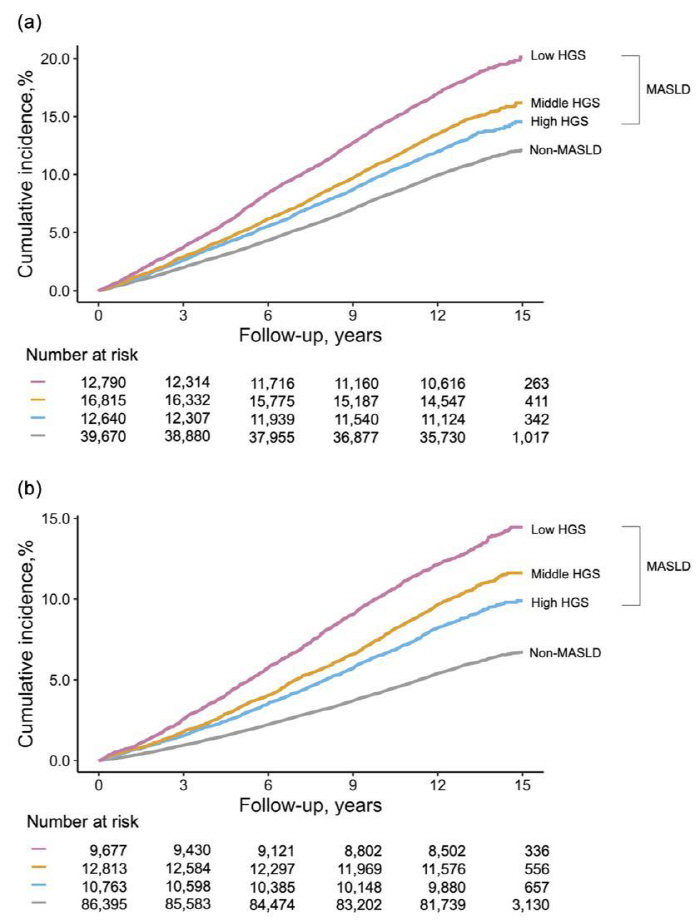Metabolic abnormal fatty liver disease, weak muscle strength increases the risk of cardiovascular disease
Apr 04, 2025
|
Metabolic fatty liver disease (MASLD) is a disease called 'non-alcoholic fatty liver' with metabolic abnormalities such as obesity, high blood pressure, hyperlipidemia, and diabetes and excessive accumulation of fat in the liver. It is known that one in three people in the world has metabolic abnormal fatty liver disease, and its prevalence is on the rise.
Since cardiovascular disease is the leading cause of death in metabolic abnormal fatty liver disease, it is very important to find high-risk groups for cardiovascular disease. In metabolic abnormal fatty liver disease, it has been reported that a decrease in muscle strength or muscle mass increases the risk of cardiovascular disease, but most of them were cross-sectional studies that looked only at one point in time. Accordingly, the research team wanted to find out through longitudinal studies whether the actual risk of cardiovascular disease varies depending on muscle strength in metabolic fatty liver disease.
The study used data from about 200,000 UK Biobank examinees. The grip strength, which is deeply related to whole-body strength, was used to measure muscle strength. Metabolic abnormal fatty liver disease was defined as having steatosis in the liver and having at least one of the metabolic abnormalities. Cardiovascular disease incidence followed the diagnostic name of the International Classification of Diseases Code (ICD-10).
Examinees with metabolic abnormal fatty liver disease were divided into low grip strength, medium grip strength, and high grip strength according to grip strength, and differences in cardiovascular disease occurrence were analyzed with examiners without metabolic abnormal fatty liver disease.
An average follow-up of 13.1 years showed that the risk of cardiovascular disease was lowest in the group without metabolic abnormal fatty liver disease. The risk of cardiovascular disease was then high in the order of high grip strength, intermediate grip strength, and low grip strength among the groups with metabolic abnormalities of fatty liver disease. These results were the same for both men and women.
As a result of confirming the risk ratio of cardiovascular disease through multivariate analysis, men with metabolic abnormal fatty liver increased the risk of cardiovascular disease in the order of high grip (1.03), intermediate grip (1.14), and low grip (1.38), and women with metabolic abnormal fatty liver in the order of high grip (1.07), intermediate grip (1.25), and low grip (1.56).
This study is meaningful in that it has proven through large-scale long-term follow-up data that the lower the grip strength in metabolic abnormal fatty liver disease, the higher the risk of cardiovascular disease.
Professor Lim Tae-seop said, `The results of this study suggest that lowering muscle strength can increase the risk of developing cardiovascular disease, which is the leading cause of death from metabolic abnormal fatty liver disease, and that muscle strength management is important in this patient group.'"In the future, further studies are needed to confirm whether there is an effect on preventing cardiovascular disease through interventions that strengthen actual muscle strength, and this study can be used as a basis for this."
Professor Kim Kyung-min "In the meantime, various studies have emphasized the clinical importance of sarcopenia. This study once again suggests that efforts to maintain and improve muscle strength in fatty liver patients are also important" and emphasized that while muscle strength and muscle mass are inevitably reduced during aging, efforts to maintain them through proper nutrition and steady exercise are essential for healthy aging."
The findings were recently published in the international journal 『Journal of Cachexia, Sarcopenia and Muscle (IF 9.4)"
|
This article was translated by Naver AI translator.















